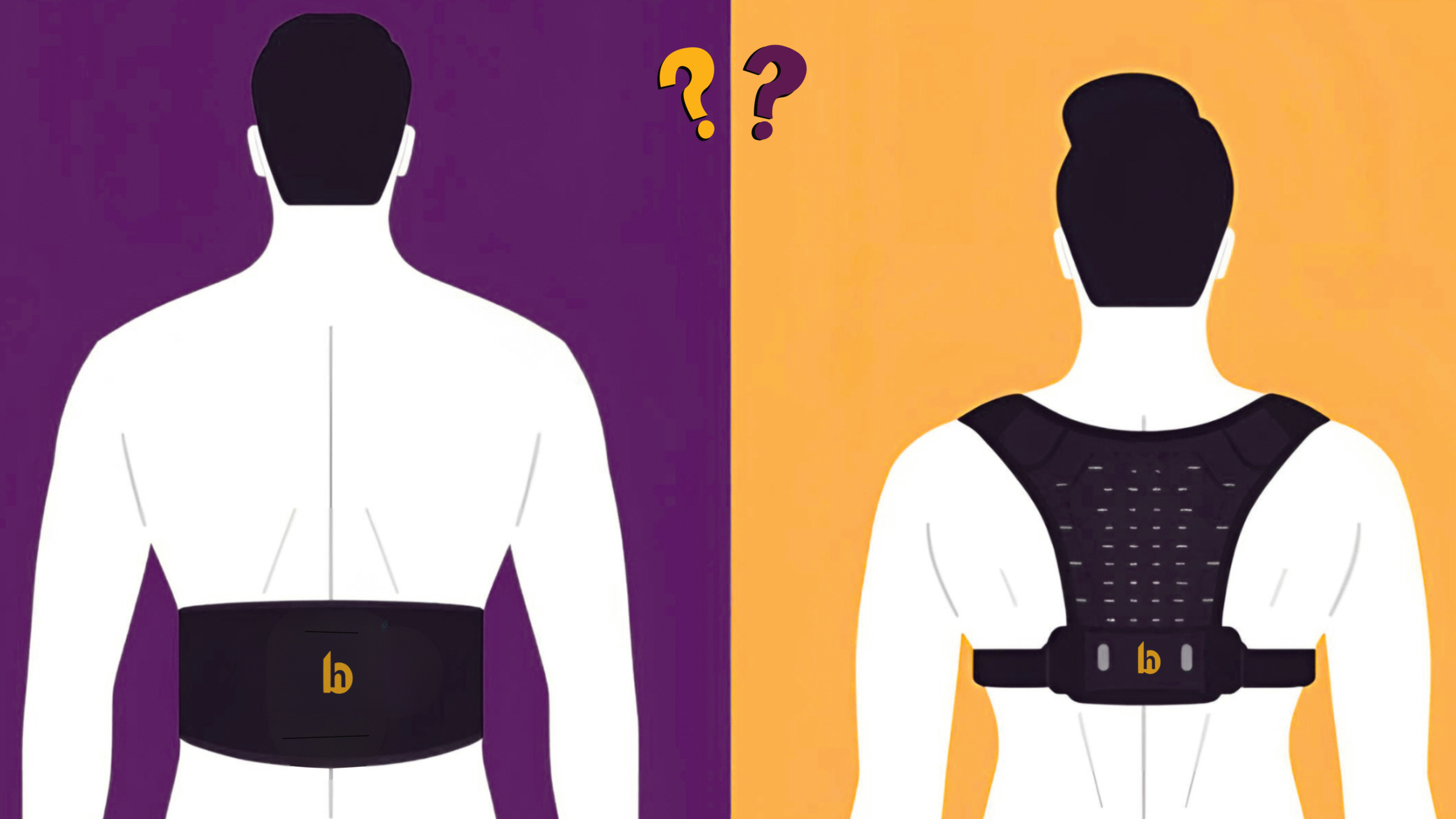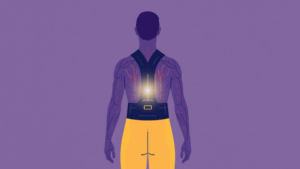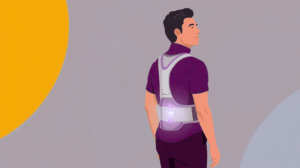If you’ve ever googled ‘how to fix bad posture’, then you might have come across belts and braces for posture correction. But do they actually work, or are they just expensive straps? That primary keyword is vital here because millions of people are stuck wondering which gadget will truly help their posture and whether either is worth the investment.
In this article, we’ll cut through the noise and compare posture corrector belts and braces head-to-head, learn about the real differences, the science behind them, who should wear what, and the hidden pitfalls that most brands never tell you. By the end, you’ll know exactly which option fits your body, lifestyle, and long-term goals.
What Are the Facts: Can a Belt or Brace Actually Fix Bad Posture?
Let’s start with what the research says. A posture brace for back pain or a posture corrector belt for both men and women might feel helpful, but do they actually change your alignment long term?
- Studies on lumbar belts suggest that belts can help reduce lower back pain in some people, especially when they are used correctly and fit according to their body shape. But the effects often fades away when the belt is removed.[1]
- On posture braces: they can pull your shoulders back, give you immediate visual improvement, and act as reminders for your body to stay upright. But they don’t often strengthen the muscles that hold you in alignment.[2]
- Experts warn of muscle dependency: if you let a brace or belt do all the work, your core and back muscles may get lazy.[3]
So the science supports what many experienced users say: devices help, but are not enough by themselves. The real fix comes from combining them with posture awareness, strengthening exercises, and good ergonomic habits.
Posture Corrector Belts: Could a Simple Belt Be the Game-Changer for Your Back ?
Think of a posture corrector belt as a soft yet firm wrap around the midsection of your body, usually targeting the lumbar (lower back) area. Many users describe it as a comforting hug for their spine.
The Upside:
- Discreet and wearable anywhere: You can wear it under clothes at the office, in the car, or even while traveling.
- Great for long sitting hours: Office workers and drivers find relief from lower back tension.[4]
- Adjustable compression: Many belts let you tighten or loosen support based on your comfort.
The Downside:
- Muscle dependency risk: Rely on it too much, and your core muscle may weaken.
- Doesn’t address upper back or shoulders: Sure, you’ll feel relief in the lumbar region, but it doesn’t do much for your upper back area. You’ll still slouch forward.
- Temporary fix: It supports posture but doesn’t retrain muscles.
Fun fact : Wearing a belt feels like having a safety net but lean on it for too long, and you might never learn to walk the tightrope on your own.
Posture Braces: Instant Relief or Just a Painful Illusion?
Posture braces are designed for your upper body, especially your shoulders and upper spine. They usually look like backpack straps that pull your shoulders back into alignment.
The Upside:
- Instant results: As soon as you put it on, you’ll notice your shoulder straightening up.
- Best for screen slouchers: Students, gamers, and office workers get immediate correction for rounded posture.
- Habit trainer: It constantly reminds your body to stay upright.
The Downside:
- Restrictive: Many users find them uncomfortable after 30–60 minutes.
- Not ideal for long-term wear: If over-tightened , it may strain or cut the circulation. Doesn’t support the lower back: If your pain starts below the waist, braces won’t help.
Fun fact : A brace feels like a strict teacher correcting you every minute but you may grow to resent it.
Belt vs Brace: Which One Feels Better and Works Better for You?
You want something that doesn’t feel like medieval armor, right? Let’s break down how posture corrector belts and braces actually compare in comfort, usability, and effectiveness:
1. Comfort & Daily Wear
- Posture Corrector Belt: It tends to be softer around the torso and lower back, making it easier to wear under clothes. Works well for men and women who sit for long hours at desks or while driving.
- Posture Brace: Wraps around the shoulders and upper back. Can rub under the arms or feel tight after some time, which makes it less comfortable for all-day wear.
2. Area Targeted
- Posture Corrector Belt: Focuses mainly on the lumbar or lower back. Best for people with pain in the lower spine or those who slouch forward at the waist/hips.
- Posture Brace: Targets the upper back, shoulders, and clavicle. More effective for “rounded shoulders” or a collapsed chest posture.
3. Speed of Visible Change
- Posture Corrector Belt: It works more gradually, you may feel relief in the lower back over days or weeks.
- Posture Brace: Offers faster visual correction of shoulder alignment. However, instant improvement doesn’t always mean lasting posture strength.
4. Best Lifestyle Fit
- Posture Corrector Belt: Better suited for office workers, drivers, and anyone who spends long hours sitting. If you’re looking at a back support belt vs brace comparison for continuous use, belts usually win.
- Posture Brace: Great for students, gamers, and phone users who often struggle with “tech neck” or upper back pain.
Quick takeaway:-
If your main issue is lower back pain, a posture corrector belt might serve you better. If your back pain comes from your shoulders being hunched or your chest being collapsed, a brace may give quicker relief. But neither alone solves all posture problems.
What Are the Hidden Dangers Nobody Warns You About?
Using belts or braces isn’t totally risk-free, even though the marketing would have you believe otherwise. Awareness is the real power.
- Muscle weakening or atrophy: Relying too much on external support reduces the work your muscles do; over time those postural muscles (core, spinal erectors, shoulder stabilisers) can become weaker.[5]
- Skin irritation, discomfort: Poor fit, poor materials, tight straps causes rubbing, redness, even numbness in some cases.[6]
- Restriction of movement: If a brace is too rigid, or a belt too tight, your natural motion gets limited. That might fix posture briefly but it also stresses nearby joints and tissues.⁶
- Mental dependency / false sense of security: You might start thinking “as long as I wear the brace, I’m fine,” leading to neglect of posture when brace is off.[7]
So, always use these tools in moderation, and pair them with exercises and posture awareness.
How to Choose the Best Posture Aid: Belt or Brace?
Here’s a buyer’s checklist (because yes, there are good ones, and yes, there are meh ones).
- Adjustability – Straps that let you fine-tune tightness; belts that accommodate your waist and hips; braces that don’t cut into underarms.
- Support zone – If you have lower back pain, a support belt might wrap around the lumbar region; if upper back/shoulder slouching, go for a brace or hybrid style.
- Material & comfort – Breathable fabric, padding where needed; avoid rigid plastic unless prescribed.
- Time recommendation – Look for products that suggest usage durations (e.g., start with 20–30 minutes/day, gradually increase).
- Professional advice – Especially if the pain is severe, chronic, or linked to injury. Physical therapists can assess posture brace vs posture corrector differences specific to you.[8]
- Reviews & endorsements – Real user reviews (what comfort is like, how easy to wear), plus medical or physiotherapy endorsements.
If Neither Belt Nor Brace Is Enough Alone, What Actually Works?
This section is where we get practical. Think of belts and braces as training wheels, not as a substitute for riding the bike.
What to Pair With Device Use?

- Strengthening exercises
- Core work (planks, bird dogs)
- Back extensors
- Shoulder external rotators & scapular retractors
- Stretching and mobility
- Pectoral/ chest stretch (to counter slouch)
- Hip flexor stretches (tight hips pull the pelvis, affect lumbar spine)
- Ergonomics
- Setup your desk: monitor at eye-level, chair height so knees at ~90°, feet flat.
- Phone/head position: avoid tech neck by raising screen or bringing phone up.
- Mindfulness / habits
- Reminders (alarms, posture apps)
- Frequent position changes : Stand every 30–45 minutes, walk around.
- Gradual weaning
- Use a belt or brace for short periods; then try without to test muscle control.
- Slowly reduce dependency.
When combined, these strategies tend to lead to lasting improvements rather than temporary relief.
So, What’s the Verdict? Belt, Brace, or “Both, but Smartly”?
If I were advising a friend (which I am, because you’re a friend reading this!), here’s what I’d recommend:
- If your back pain is lower lumbar (hips, lower back) → start with a posture corrector belt. It gives relief, support, without being too restrictive.
- If your issue is shoulders slumping forward, upper back rounding, or tech-neck, get a posture brace. You’ll see faster visual alignment in shoulders.
- If you have multiple issues (upper + lower), try combining but be careful: start small, limit usage, ensure comfort.
- Always pair the device with strength training, stretching, ergonomic improvements, posture awareness. Otherwise, both belt and brace risk becoming crutches.
- The best posture corrector for back pain isn’t necessarily the “most supported” device, it’s the one you will use correctly, comfortably, and as part of a plan.
Common Mistakes to Avoid When Using Belts or Braces
Because “just buy a brace or belt” seems simple, but people often mess up. Friendly reminder:
- Wearing it too long, too tight (leading to discomfort, circulation issues).
- Using devices but neglecting muscles → dependency.
- Getting cheap, ill-fitting devices that don’t adjust or suit your body shape.
- Ignoring ergonomics (if your chair, screen, posture at desk are bad, the belt/brace helps little).
- Expecting instant fix → frustration.
Can a Posture Corrector Belt and Posture Brace Be Used Together All Day?
You may wonder: “Could I wear both a lower back belt and an upper back brace all day, so I’m perfectly straight all the time?” Sounds aggressive but not always smart.
You might think: “Why not combine both a belt for my lower back, a brace for my shoulders and get the best of both worlds.” Right ? Let’s look into some pros and cons for using them together:-
Pros:
- Combined use can help correct multiple posture issues like lower back + upper back, + shoulders.
- It acts like a full “posture reset” during times when you are awake and relatively sedentary (desk work, driving).
Cons:
- It might lead to misaligned pressure, belt pushing one way, brace pulling another.
- Increased risk of over-correction pressure points, skin chafing, sweating, general discomfort and even altering your natural spinal curves if overused.
- Risk: muscles not getting activated much at all.
- Might make it harder to exercise or move freely, making muscle strengthening tricky.
If you want continuous support:
- Limit to parts of the day when posture suffers most (e.g. during prolonged desk work).
- Remove during rest, movement, sleep.
- Use as cue/reminder rather than rigid constraint.
So, yes, belts and braces can help your body posture but mostly as temporary aids. If you try both, use each in limited doses (maybe 30–60 minutes at a time), ensure good fit, and gradually wean off. The real fix comes from combining them with posture awareness, strengthening exercises, and good ergonomic habits.
Final Thoughts: Using Belt or Brace, but Only As Part of a Plan
To sum up (without sounding like a cheesy self-help ad): posture corrector belt vs posture brace isn’t about choosing a winner; it’s about choosing the right tool for your situation, then using it smartly.
- These devices are reminders and supports. They don’t replace muscle strength, ergonomic workstations, or movement.
- Use them in short slivers of your day when posture tends to collapse.
- Build the habit of checking your posture without the device ; stand, sit, walk with awareness.
Your body is resilient. With a thoughtful plan, some sweat (yes, actual muscle work), and consistency, the gadget becomes optional. And that’s the real goal.
FAQs: Your Burning Questions, Answered
1. Can wearing a posture brace or belt permanently correct bad posture?
Not by itself. These devices help temporarily and improve awareness. Permanent correction usually requires strengthening weak muscles, stretching tight ones, improving ergonomics, and building posture habits over time.
2. How long should I wear a posture corrector belt or brace each day?
Start small—20-30 minutes per day. Gradually increase if comfortable, but avoid all-day continuous use unless advised by a health professional. Overuse can cause dependency and muscle weakening.
3. Is a posture corrector belt for men and women the same, or do we need gender specific designs?
Most belts and braces are unisex, but fit is key. Body shape differences (torso length, shoulder width, waist/hip ratio) matter. Choose adjustable designs; ensure comfort under clothing, avoid rubbing or pinching.
4. Which is better if my back pain is mostly in the lower back vs mainly in shoulders/upper back?
Lower back issues are often better helped by lumbar posture corrector belts or belts designed to support the sacro-lumbar region. Shoulder or upper back pain often needs braces that pull the shoulders and upper spine into better alignment.
5. Are there any risks in using belts or braces during exercise or movement?
Yes. Some braces restrict movement which can affect form. Compression belts might shift with twisting or heavy lifting. Using them during exercise should be done carefully; ideally with professional guidance. Also ensure the device doesn’t restrict breathing or cause discomfort.
6. How do I know I’m choosing the right device, and when should I consult a professional?
If pain is severe, chronic (lasting many weeks), or interfering with daily life, always consult a physiotherapist or doctor. Right device = adjustable, well-fitted, comfortable, breathable material, and suggestion for usage time. Wrong devices will irritate or worsen pain.
Explore More Health & Wellness Solutions
Want to stay informed about wellness and everyday health issues? Here are some insightful reads to guide you. Explore the links below for practical tips and solutions:-
- https://betterhood.in/learn/what-causes-back-pain/
- https://betterhood.in/learn/can-your-sitting-posture-cause-hip-misalignment/
- https://betterhood.in/learn/create-a-pain-free-office-in-3-simple-steps/
- https://betterhood.in/learn/supplements-for-cognitive-function/
- https://betterhood.in/learn/coccyx-cushions-vs-donut-cushions/
References:
- Bonnaire, R., Han, W.-S., Calmels, P., Convert, R., & Molimard, J. (2020). Parametric study of lumbar belts in the case of low back pain: effect of patients’ specific characteristics. ArXiv. https://arxiv.org/abs/2009.02923 arXiv
- Leung, M., Kan, M. M. P., Cheng, H. M. H., De Carvalho, D. E., Anwer, S., Li, H., & Wong, A. Y. L. (2023). Effects of Using a Shoulder/Scapular Brace on the Posture and Muscle Activity of Healthy University Students during Prolonged Typing — A Randomized Controlled Cross-Over Trial. Healthcare, 11(11), 1555. https://doi.org/10.3390/healthcare11111555 NCBI
- Vick, J. S., & El-Emam, A. (2024). Efficacy of back bracing in treating chronic low back pain. Brain Sciences, 14(11), Article 1100. https://doi.org/10.3390/brainsci14111100 MDPI
- Im, S.-C., Cho, H.-Y., Lee, J.-H., & Kim, K. (2021). Analysis of the effect of wearing extensible and non-extensible lumbar belts on biomechanical factors of the sit-to-stand movement and pain-related psychological factors affecting office workers with low back pain. Healthcare, 9(11), Article 1601. https://doi.org/10.3390/healthcare9111601 MDPI
- van Poppel, M. N., Hosman, A., & van Riel, M. (2007). Effect of wearing a lumbar orthosis on trunk muscles: study of the muscle strength after 21 days of use on healthy subjects. European Spine Journal, 16(3), 323-330. https://doi.org/10.1007/s00586-006-0168-6 PubMed
- Saurabh Dang, MD, Interventional Pain Physician,(2018) How to use and wear a lower back brace.https://www.spine-health.com/treatment/alternative-care/how-use-and-wear-lower-back-brace?utm_source=chatgpt.com
- BestPostureCorrector.com. (n.d.). What Are the Side Effects of Posture Correctors? Retrieved from BestPostureCorrector.com bestposturecorrector.com
- Quantafitness.com. (n.d.). Understanding Posture Correctors: A Medical Perspective. Retrieved from Quantafitness.com QuantaFitness























